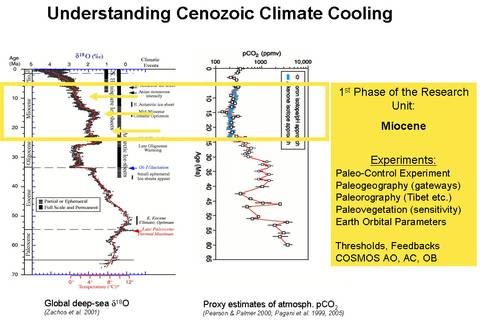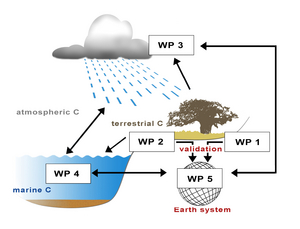To address the objectives given above, partners from seven institutes will form a consortium and contribute to five working packages to ensure maximum gains from the different activities and expertise provided to the project. The consortium will intimately merge data measurements, climate modeling, and analyses. The close link between modeling work and paleodata time-series reconstruction will be fostered through the analysis of the temporal and spatial temperature and precipitation patterns which are robust in the model experiments and in the paleodata records. The workpackages are:
WP 1
Changes in continental climate, vegetation, and weathering during the Cenozoic cooling as derived from proxy-data
Volker Mosbrugger/Senckenberg, Louis François/Université de Liège
Vegetation and climate maps for selected time intervals of the Cenozoic are reconstructed using plant fossils (palynofloras and megafloras) as proxies. The vegetation maps will be based on the biome approach in combination with numerical vegetation modeling as a tool for the additional data assimilation. Furthermore, the dynamic vegetation model will provide the geographic distributions of vegetation/soil carbon stocks and fluxes. They will be used to estimate the export of soil organic matter to the river system and the ocean, as well as to evaluate the soil CO2 partial pressures, which in combination with paleoclimatic reconstructions (temperature, runoff), will allow the modeling of the distribution of weathering rates over the continents (input to WP4).
WP 2
African climate changes during C4 plant evolution and expansion
Enno Schefuß/Universität Bremen, Lydie Dupont/Universität Bremen
Based on terrigenous plant lipid biomarkers and their molecular carbon and hydrogen isotopic signatures, and on the analysis of pollen in marine sediments of the equatorial and South Atlantic, this project will provide data for identifying the controlling factors of C3/C4 vegetation changes and to quantify the consequences for Cenozoic carbon fractionation and the geographical distribution of carbon pools.
WP 3
Global atmospheric chemistry climate modeling
Martin Schultz/FZ Jülich, Gerrit Lohmann/AWI
The global distribution of potential wetlands and their methane (CH4) emissions at the present-day and during the Cenozoic climate will be estimated. Budgets are based on general circulation model simulations including a dynamic vegetation model (WP1). Simple algorithms for determining wetland area based on paleo-topography and soil moisture, and estimates of CH4 emissions based on ecosystem carbon turnover in wet soils will be applied.
The main focus is the estimation of the sinks of methane and other atmospheric compounds applying a recent-developed atmospheric chemistry module. Interactions with the climate dynamics are evaluated in this workpackage.
WP 4
Cenozoic climate, thermohaline circulation and the marine carbon cycle
Torsten Bickert/Universität Bremen
This project will focus on the biogeochemical role of the oceans in Cenozoic climate cooling.
It will study the links between past ocean circulation, marine carbon cycling and continental weathering using numerical models of different complexity levels. The model results will be validated with marine proxy data records in collaboration with WP2. Furthermore, this project will provide boundary conditions for numerical modeling in WP5. Conversely, in the course of the research project, modeling in WP4 will be refined by implementing updated atmospheric boundary conditions (WP3) and by geochemical weathering fluxes (WP1).
WP 5
Cenozoic climate: Earth System modeling and analysis
Gerrit Lohmann/AWI, Johann Jungclaus/ZMAW, Arne Micheels/Senckenberg
Using climate and vegetation modeling with a complex climate model, the work package analyses the sensitivity on palaeogeographic, palaeovegetation and ocean gateway changes, and on variations of the orbital parameters for a warm climate situation. Special emphasis is furthermore set on the influence of high-latitude forests/wetlands on the hydrological and carbon cycle as well as the atmosphere-ocean circulation. In cooperation with WP 4 it will allow systematic feedback analysis of the climate system components. The reliability of the model results will be validated with terrestrial and marine proxy data.




